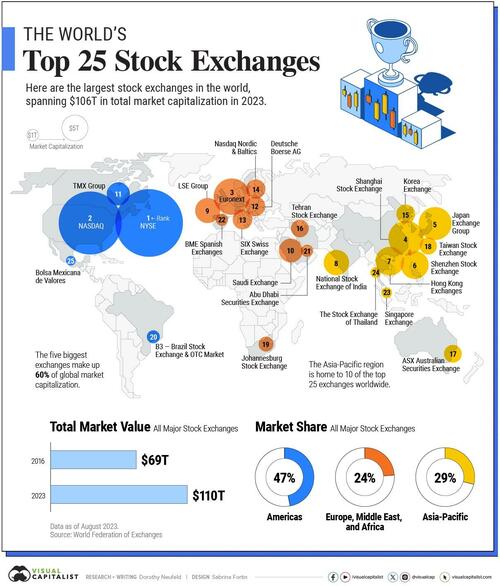US Still Dominates The World’s Largest Stock Exchanges
Today, there are roughly 80 major stock exchanges worth a combined $110.2 trillion in value.
The world’s top two exchanges, the New York Stock Exchange (NYSE) and the Nasdaq, command 42.4% of global market capitalization.
Despite the rapid growth of emerging economies, the U.S. continues to lead capital markets by a wide margin—even as countries such as India see considerable growth, surpassing the UK in 2023.
This visualization, via Visual Capitalist’s Dorothy Neufeld and Sabrina Fortin, shows the largest stock exchanges in the world, with data from the World Federation of Exchanges (WFE).
Top Stock Exchanges, by Market Cap
Here are the top 25 largest stock markets covering 96.6% of total stock market capitalization:
| Global Rank | Stock Exchange | Country | Market Cap Aug 2023 |
|---|---|---|---|
| 1 | NYSE | 🇺🇸 U.S. | $25.0T |
| 2 | Nasdaq | 🇺🇸 U.S. | $21.7T |
| 3 | Euronext | 🇳🇱 Netherlands | $7.2T |
| 4 | Shanghai Stock Exchange | 🇨🇳 China | $6.7T |
| 5 | Japan Exchange Group | 🇯🇵 Japan | $5.9T |
| 6 | Shenzhen Stock Exchange | 🇨🇳 China | $4.5T |
| 7 | Hong Kong Exchanges | 🇭🇰 Hong Kong | $4.2T |
| 8 | National Stock Exchange of India |
🇮🇳 India | $3.5T |
| 9 | LSE Group | 🇬🇧 UK | $3.4T |
| 10 | Saudi Exchange | 🇸🇦 Saudi Arabia | $3.1T |
| 11 | TMX Group | 🇨🇦 Canada | $2.9T |
| 12 | Deutsche Boerse AG | 🇩🇪 Germany | $2.1T |
| 13 | SIX Swiss Exchange | 🇨🇭 Switzerland | $2.1T |
| 14 | Nasdaq Nordic and Baltics |
🇸🇪 Sweden, Denmark, Finland and Iceland |
$2.0T |
| 15 | Korea Exchange | 🇰🇷 South Korea | $1.9T |
| 16 | Tehran Stock Exchange | 🇮🇷 Iran | $1.7T |
| 17 | ASX Australian Securities Exchange |
🇦🇺 Australia | $1.7T |
| 18 | Taiwan Stock Exchange | 🇹🇼 Taiwan | $1.6T |
| 19 | Johannesburg Stock Exchange |
🇿🇦 South Africa | $1.2T |
| 20 | B3 – Brazil Stock Exchange and OTC Market |
🇧🇷 Brazil | $0.9T |
| 21 | Abu Dhabi Securities Exchange | 🇦🇪 Abu Dhabi | $0.8T |
| 22 | BME Spanish Exchanges | 🇪🇸 Spain | $0.8T |
| 23 | Singapore Exchange | 🇸🇬 Singapore | $0.6T |
| 24 | The Stock Exchange of Thailand |
🇹🇭 Thailand | $0.6T |
| 25 | Bolsa Mexicana de Valores |
🇲🇽 Mexico | $0.5T |
The NYSE ($25.0 trillion) and the tech-heavy Nasdaq ($21.7 trillion) are home to many of the world’s most valuable firms, from Apple to Nvidia. Since 2016, the NYSE has grown 35.1% while the Nasdaq has ballooned 189.3% in market cap.
The vast majority of companies in the S&P 500 Index, often seen as a barometer for U.S. stock market performance, are traded on these exchanges.
With $7.2 trillion in market cap, Euronext is the world’s third-largest exchange. Since Brexit, the pan-European exchange has attracted more capital and by early 2021, it outranked the London Stock Exchange. Over the last two decades, London’s stock market has fallen from 13% to 4% of the global share.
Ranking fourth is the Shanghai Stock Exchange, at $6.7 trillion in market cap. Beverage giant Kweichow Moutai, ICBC, and PetroChina are the largest companies traded on the exchange.
Like China, as India’s economy has continued to expand, so has its primary stock market. As the twelfth-largest globally, it’s worth $3.5 trillion in market cap, growing over 133% in market value since 2016.
Should You Invest Internationally?
While U.S. stock markets are unmatched in scale in the global arena, investors may look to diversify exposure across the pond.
In fact, by 2050, Goldman Sachs projects that emerging markets’ share of global stock market capitalization will surpass America. Given the strong economic growth of emerging markets, investors may find opportunities in broad market indexes that track these countries through investment vehicles like ETFs or mutual funds.
Yet while international markets may provide opportunities for diversification, they may also present risk given political, regulatory, and economic factors.
Tyler Durden
Mon, 10/23/2023 – 22:00
via ZeroHedge News https://ift.tt/zteCWmX Tyler Durden
